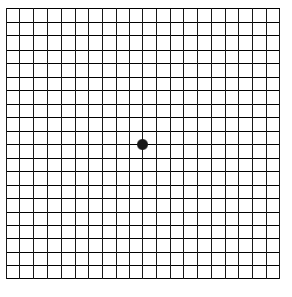Vision
- illusions
- primary colors, complimentary colors
- color blindnes
- macular degeneration
- motion and pattern recognition
- blind spot
- dominant eye
- retinal fatigue
- human eye

| Test for Macular Problems: Amsler Grid
Make sure your room lights are on. Put on your reading glasses if you wear them, and test each eye separately (cover one eye at a time). Concentrate on the center spot . If the lines appear wavy, or if their are spots or holes in the grid, then you may have a macular problem |
 |
Motion and Pattern Recognition
Printout the following two GIF images and photocopy them on transparencies. Overlay the fish on the background and ask the students what they see. Most likely, they will be unable to detect the fish until you move it.


Dominant Eye: Hold both hands out at arm's length and position them so as to make a box around the circle above. Keeping both eyes fixed on the object, slowly move your hands toward your face, keeping the circle in the center of the box. The eye to which your hands move is your dominant eye.
Other Online Vision Experiments are available at the Exploratorium website.
Primary Colors (From Hands-On Physics). Online activity available.
Concepts to Investigate: Additive properties of light, primary colors.
Materials: Red, green, and blue lights (use Christmas lights for a small scale investigation, and flood lights for a classroom demonstration), electric drill (any rapidly spinning spindle will work), bolt, nuts, washer, disk, paints or markers (red, green and blue).
Principles and Procedures: Examine a color computer or television monitor using a magnifying lens, and note that the screen is composed of numerous pixels (picture cells) which occur in triplets. Each triplet has a red, green, and blue dot. By illuminating different combinations of these dots at varying intensities, the monitor produces a wide range of colors. Red, green, and blue light are considered the primary colors because they can be projected in different combinations to produce all other colors. Some restaurants have large screen projection monitors on which they broadcast sports events. By casting beams of red, green and blue light onto a screen these monitors generate enough colors to produce a life-like effect. In this activity you will make your own "big screen" monitor.
Part 1: Additive Colors: Darken the room, and adjust the red, green, and blue lights so they shine on the same white surface as illustrated in figure I. Note that the screen appears white where the three beams overlap. Now turn on just the red and the blue lights and describe the color produced. Place an object close to the screen and note the color of the two shadows. Repeat with the red and green lights followed by the blue and green lights. Now turn on all three lights and place an object such as your hand or a ball in front of the beams as shown on figure I. Since the object is illuminated from three different locations, it will cast three separate shadows. Where red is blocked, the shadow will be composed of only blue and green light. What color is produced when blue and green light are combined? Where green light is blocked, the shadow will be composed of red and blue light. What color is produced when red and blue light are combined? Where blue light is blocked, the shadow will be composed of red and green light. What color is produced when red and green light are combined? Record your findings.
Part 2: Color Wheel: The image on a computer monitor is created as a beam of electrons streams rapidly back and forth across the screen in rows from top to bottom. Phosphorous zones on the screen glow when they are hit by electrons, and remain black when they are not, creating an image from a series of bright and dark dots. The electron beam sweeps back and forth across the screen so rapidly that our eyes can not detect that the glowing dots are actually turning on and off, so the picture appears smooth and continuous to our eyes. In a similar fashion, the spokes of a rapidly spinning bicycle wheel appear to blend into a smooth blur. If a disk painted in the three primary colors is spinning rapidly, will we be able to see all of the colors distinctly, or will they blend into a composite image? If they blur together, will they combine to form white light the way red, green, and blue dots do on a computer screen?
Cut a circular disc from a piece of heavy cardboard or thin plywood. Divide it into three equal sections and paint these red, green, and blue as illustrated in figure J. Drill a hole in the center of the disk and mount it on a long bolt using lock washers and nuts. Tighten the nuts securely so they will not loosen while the bolt rotates. Tighten the bolt in the chuck of the drill and turn on (figure K). View the disk in bright light and note its appearance. Can you see the three colors, or do they blend together into gray or white?
Questions
(1) What color is produced by mixing green and blue light? Red and blue? Red and green?
(2) How was the green shadow produced? The red shadow? The blue shadow?
(3) What is the color of the background? Why?
(4) Why must big screen projection monitors be viewed in dimly lit rooms?
(5) Do the colors on the rotating disk (part 2) blend into white? Explain.
